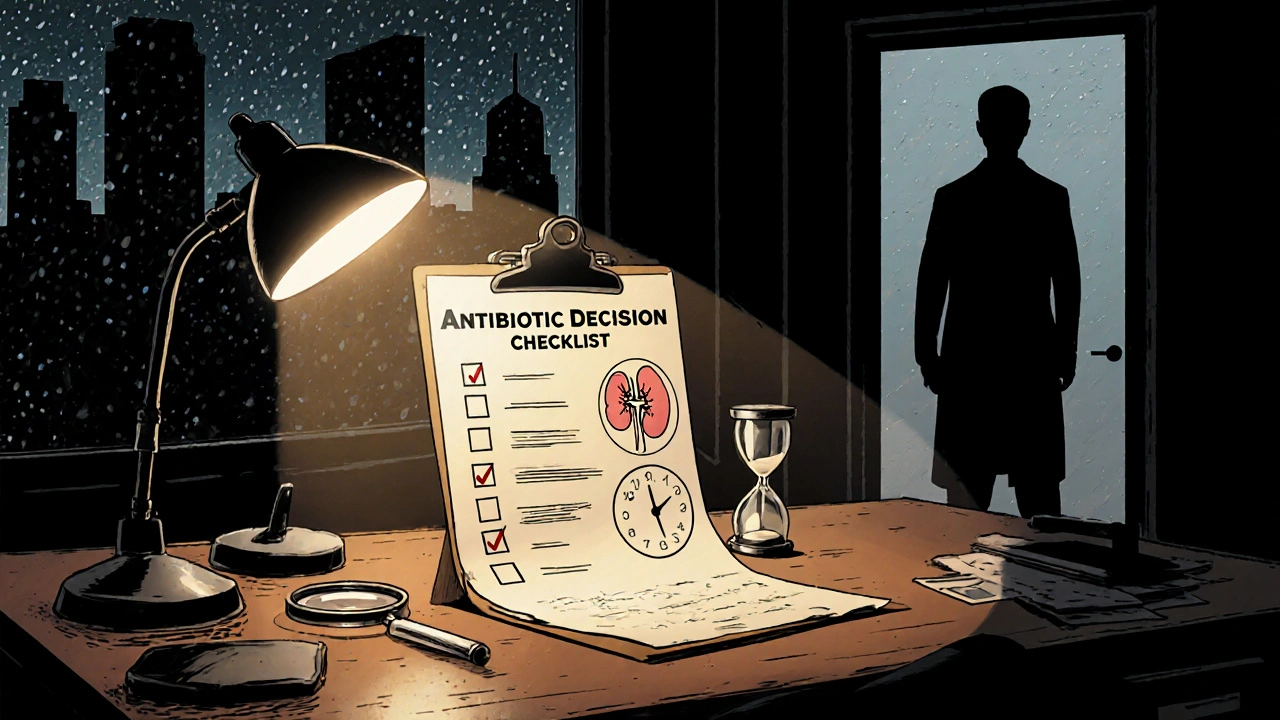Antibiotic Selection Guide
Select Infection Type
Patient Factors
Dosing Preferences
Recommended Antibiotics
Quick Takeaways
- Cephalexin is a first‑generation cephalosporin, ideal for skin, bone and urinary infections.
- Amoxicillin offers broader Gram‑negative coverage but may trigger more allergic reactions.
- Azithromycin’s once‑daily dosing is convenient for respiratory bugs, yet resistance is rising.
- Doxycycline works well for atypical organisms and Lyme disease, but it can cause photosensitivity.
- Choosing the right drug depends on infection type, patient allergens, renal function and dosing convenience.
What is Cephalexin (Phexin)?
Cephalexin is a first‑generation cephalosporin antibiotic marketed in the UK under the brand name Phexin. It was approved for clinical use in 1971 and works by inhibiting bacterial cell‑wall synthesis, leading to cell lysis. Typical oral doses range from 250mg to 1g taken every 6hours, and it is excreted unchanged by the kidneys.
How Cephalexin Works and When It’s Used
Cephalexin binds to penicillin‑binding proteins on the bacterial surface, disrupting the final steps of peptidoglycan cross‑linking. This makes it especially effective against Gram‑positive cocci such as Staphylococcus aureus (non‑MRSA) and Streptococcus pyogenes. Clinicians commonly prescribe it for:
- Uncomplicated skin and soft‑tissue infections (cellulitis, impetigo)
- Bone infections (osteomyelitis) when the causative organism is known to be susceptible
- Uncomplicated urinary‑tract infections caused by E.coli that remain sensitive
- Prophylaxis before certain dental procedures for patients with prosthetic joints
The drug’s safety profile is favorable for most adults, but dose adjustment is required for patients with a creatinine clearance below 30mL/min.
Common Alternatives to Cephalexin
When a doctor can’t use Cephalexin-perhaps due to a penicillin allergy, bacterial resistance, or dosing constraints-they often turn to one of the following antibiotics. Each belongs to a different class, offering a distinct spectrum and set of side effects.
- Amoxicillin - a broad‑spectrum penicillin active against many Gram‑negative and Gram‑positive organisms; typical dose 500mg three times daily.
- Azithromycin - a macrolide with a long half‑life, allowing once‑daily dosing; often prescribed for respiratory infections; dose 500mg daily for three days.
- Doxycycline - a tetracycline effective against atypical bacteria and tick‑borne diseases; dose 100mg twice daily.
- Clindamycin - a lincosamide useful for anaerobic infections and MRSA skin infections; dose 300mg four times daily.
- Penicillin V - a narrow‑spectrum penicillin best for streptococcal pharyngitis; dose 500mg three times daily.

Side‑Effect Profiles at a Glance
| Antibiotic | Class | Typical Oral Dose | Key Spectrum | Common Side Effects | Major Contra‑indications |
|---|---|---|---|---|---|
| Cephalexin (Phexin) | Cephalosporin (1st gen) | 250‑500mg q6h | Gram‑positive, limited Gram‑negative | Diarrhoea, mild rash, nausea | Severe cephalosporin allergy, renal failure (dose adjust) |
| Amoxicillin | Penicillin | 500mg t.i.d. | Broad Gram‑positive & Gram‑negative | GI upset, rash, possible C.difficile | Penicillin allergy, severe renal impairment |
| Azithromycin | Macrolide | 500mg daily ×3days | Respiratory Gram‑negatives, atypicals | Abdominal pain, QT prolongation | Known macrolide allergy, severe liver disease |
| Doxycycline | Tetracycline | 100mg b.i.d. | Atypicals, rickettsiae, Borrelia | Photosensitivity, oesophagitis | Pregnancy, children <8yr, severe hepatic disease |
| Clindamycin | Lincosamide | 300mg q6h | Anaerobes, MRSA | Diarrhoea (C.difficile risk), metallic taste | History of C.difficile colitis, colistin cross‑reactivity |
Pros and Cons of Each Option
Let’s break down the strengths and weaknesses of Cephalexin compared with the four most common stand‑ins.
Cephalexin vs Amoxicillin
Pros of Cephalexin: better stability against ß‑lactamases that knock out amoxicillin; lower risk of C.difficile infection; safe in patients with mild penicillin allergy (cross‑reactivity is rare).
Cons of Cephalexin: narrower Gram‑negative coverage; requires four doses a day, which can hurt adherence.
When to pick Amoxicillin: typical ear, sinus or uncomplicated pneumonia where H. influenzae is a concern, and the patient tolerates penicillins well.
Cephalexin vs Azithromycin
Pros of Cephalexin: less propensity to cause QT prolongation and fewer drug‑interaction warnings.
Cons of Cephalexin: cannot be taken once‑daily; limited activity against intracellular pathogens like Mycoplasma.
When to pick Azithromycin: patient prefers once‑daily dosing, has a history of non‑compliant twice‑daily regimens, or is being treated for chlamydia or atypical pneumonia.
Cephalexin vs Doxycycline
Pros of Cephalexin: safer for pregnant women and young children, no photosensitivity.
Cons of Cephalexin: ineffective against rickettsial diseases, Lyme disease, and many atypical respiratory bugs.
When to pick Doxycycline: suspected tick‑borne illness, acne, or infections where the organism is known to be doxycycline‑sensitive.
Cephalexin vs Clindamycin
Pros of Cephalexin: lower risk of C.difficile colitis, generally better tolerated gastrointestinally.
Cons of Cephalexin: lacks robust anaerobic coverage; not effective for MRSA‑related skin infections.
When to pick Clindamycin: deep‑seat anaerobic infections, necrotizing fasciitis, or confirmed MRSA where cephalosporins would fail.
How to Choose the Right Antibiotic for a Specific Infection
Think of antibiotic selection as a mini‑checklist. Ask yourself:
- What is the most likely pathogen? (Gram‑positive, Gram‑negative, atypical, anaerobic?)
- Does the patient have any documented drug allergies?
- Is renal or hepatic function compromised?
- How important is dosing convenience for adherence?
- Are there local resistance patterns that make one drug less reliable?
Answering these questions quickly narrows the field. For a straightforward cellulitis in a healthy adult with no penicillin allergy, Cephalexin remains a first‑line choice. If the patient reports a history of severe rash after any beta‑lactam, switch to doxycycline (if appropriate) or clindamycin for MRSA‑risk.

Safety Considerations and Drug Interactions
All antibiotics carry some risk. Here are the top safety points for each drug discussed:
- Cephalexin: watch for allergic reactions (urticaria, anaphylaxis). In patients on nephrotoxic drugs (e.g., aminoglycosides), monitor renal labs.
- Amoxicillin: may increase oral contraceptive failure; avoid with allopurinol in gout patients unless necessary.
- Azithromycin: potent inhibitor of CYP3A4; can raise levels of statins, warfarin, and certain antiarrhythmics.
- Doxycycline: binds calcium; separate dosing from dairy products and antacids to improve absorption.
- Clindamycin: high C.difficile risk; consider probiotic co‑therapy if long courses are prescribed.
Pregnant or breastfeeding women should generally avoid doxycycline and clindamycin unless the benefit outweighs risks. Always discuss any over‑the‑counter meds or supplements with a healthcare professional before starting an antibiotic.
Key Takeaway Checklist for Clinicians and Patients
- Identify pathogen class → match to antibiotic spectrum.
- Screen for allergies → avoid cross‑reactive beta‑lactams.
- Assess organ function → adjust dose for kidney or liver disease.
- Consider dosing schedule → simplify to improve adherence.
- Check local resistance data → avoid empiric choices with high failure rates.
Frequently Asked Questions
Can I take Cephalexin if I’m allergic to penicillin?
Cross‑reactivity between penicillins and first‑generation cephalosporins like Cephalexin is low (about 1‑2%). If you’ve only had a rash, many doctors will still prescribe it after a careful risk assessment. A history of anaphylaxis, however, is a clear contraindication.
Why does my doctor sometimes choose Amoxicillin over Cephalexin for a skin infection?
Amoxicillin covers a broader range of Gram‑negative bacteria, such as H.influenzae, which can be involved in mixed‑type cellulitis. If the infection looks polymicrobial or the patient lives in an area with high beta‑lactamase‑producing organisms, Amoxicillin (often paired with a clavulanic acid booster) may be more reliable.
Is it safe to take Cephalexin and a probiotic together?
Yes. Probiotics can help maintain gut flora and may reduce the risk of antibiotic‑associated diarrhoea. Just space the doses by at least two hours to avoid any potential interference with absorption.
How long should I stay on Cephalexin for a urinary‑tract infection?
The typical course is 7‑10 days for uncomplicated UTIs. Some clinicians may prescribe a shorter 5‑day regimen if symptoms resolve quickly and the pathogen is known to be susceptible.
Can I switch from Cephalexin to Azithromycin mid‑treatment?
Switching is possible, but only if there’s a clear reason-like an adverse reaction or a newly identified pathogen that requires macrolide coverage. Always finish the full prescribed duration, adding the new drug’s course to ensure total treatment time meets guidelines.


Cephalexin's pharmacodynamics hinge on its affinity for penicillin‑binding proteins, effectively disrupting peptidoglycan cross‑linking in the bacterial cell wall. Its bioavailability approaches 90%, and renal excretion remains unchanged, necessitating dose adjustment when CrCl <30 mL/min. For uncomplicated cellulitis, a regimen of 500 mg q6h achieves steady‑state concentrations above the MIC for Staph aureus (non‑MRSA). Compared to amoxicillin, it offers a narrower Gram‑negative spectrum but a superior safety profile regarding C. difficile risk. Remember to counsel patients on potential GI upset and advise hydration to mitigate nephrotoxicity 😊
Thank you for the comprehensive breakdown; the clarification on renal dosing is especially valuable for primary‑care settings. I also appreciate the emphasis on selecting agents based on pathogen susceptibility rather than convenience alone.
Honestly, the article seems to ignore the looming crisis of antimicrobial resistance!!! Why are we still touting first‑generation cephalosporins when the data suggests a surge in ESBL‑producing organisms??? And don’t even get me started on the hidden conflicts of interest that pharma companies embed in these “quick takeaways”. Is anyone else suspicious???
It is utterly astonishing that anyone would still champion cephalexin without acknowledging its glaring deficiencies. The drug’s limited Gram‑negative coverage renders it obsolete in the modern era of multidrug‑resistant pathogens. Moreover, the article glosses over the fact that indiscriminate use fuels resistance-a scenario that only the enlightened elite can afford to overlook. One must demand higher standards in antimicrobial stewardship!
This overview lacks depth and nuance.
Cephalexin works well for skin infections. It is not very strong against gram negative bacteria. The dosage must be lowered if the kidney does not work well. Please follow the prescription exactly.
Reading this feels like a medication‑induced melancholy-so many choices, yet each comes with its own drama! The side‑effects are like an emotional rollercoaster, and the decision process can drain the soul. Still, picking the right antibiotic can save a life, so the stakes feel almost theatrical.
Hey folks, great info here! 😊 If you’re unsure about dosing, just remember to check the patient’s kidney function first-always a good habit. Stay chill and keep learning!
Excellent summary! It’s inspiring to see such clear guidance on when to use cephalexin versus broader agents. Keep up the fantastic work, and let’s continue promoting prudent antibiotic use.
Love the vibe of this post! 🙌 It really breaks down the pros and cons in a way that’s easy to digest. 👍 Keep sharing these gems!
Solid information here. The coverage details are especially helpful for quick decision‑making.
First, let me commend the author for assembling a concise yet informative comparison of cephalexin and its alternatives; such clarity is essential in the busy clinical environment. The pharmacokinetic profile of cephalexin, with its high oral bioavailability and predominant renal excretion, underscores the necessity of renal dose adjustment, a point that cannot be overstressed. In patients with a creatinine clearance below 30 mL/min, a reduction to 250 mg every 12 hours is often advisable to avoid accumulation and potential nephrotoxicity. Moreover, the spectrum of activity-primarily Gram‑positive cocci with limited Gram‑negative efficacy-makes it a superb choice for uncomplicated cellulitis, impetigo, or prophylaxis before dental procedures in prosthetic joint patients. Conversely, when dealing with mixed flora or organisms known to produce extended‑spectrum β‑lactamases, agents like amoxicillin‑clavulanate or a third‑generation cephalosporin become more appropriate. It is also worth noting that cephalexin’s side‑effect profile is generally mild; however, clinicians should remain vigilant for Clostridioides difficile infection, especially in hospitalized populations receiving concurrent broad‑spectrum agents. The comparison table provided in the article is particularly useful, yet it could be expanded to include newer oral agents such as lefamulin or omadacycline, which are gaining traction in outpatient therapy. When considering azithromycin, the convenience of a three‑day regimen is attractive, but the risk of QT prolongation mandates ECG monitoring in patients with cardiac comorbidities. Doxycycline’s unique utility against atypical pathogens and Lyme disease is undeniable, though photosensitivity remains a common complaint, warranting patient education on sun protection. Clindamycin offers excellent coverage for anaerobes and MRSA, but the potential for C. difficile colitis requires judicious use. Penicillin V, while narrow‑spectrum, remains the drug of choice for streptococcal pharyngitis when susceptibility is confirmed. In practice, the decision matrix should also factor in patient adherence, dosing frequency, drug–drug interactions, and cost considerations, as these elements often dictate real‑world efficacy. Clinicians should also re‑evaluate therapy at 48‑72 hours to ensure clinical improvement and de‑escalate when possible. Lastly, antimicrobial stewardship programs should use this type of comparative data to develop institution‑specific guidelines that balance efficacy with resistance mitigation. Overall, the article serves as a solid foundation, but ongoing updates will be necessary to reflect evolving resistance patterns and emerging therapeutics.
Just a heads‑up: many of the drug manufacturers have undisclosed ties to the research that produced these tables, so it’s wise to stay skeptical about the “neutral” tone of such overviews.